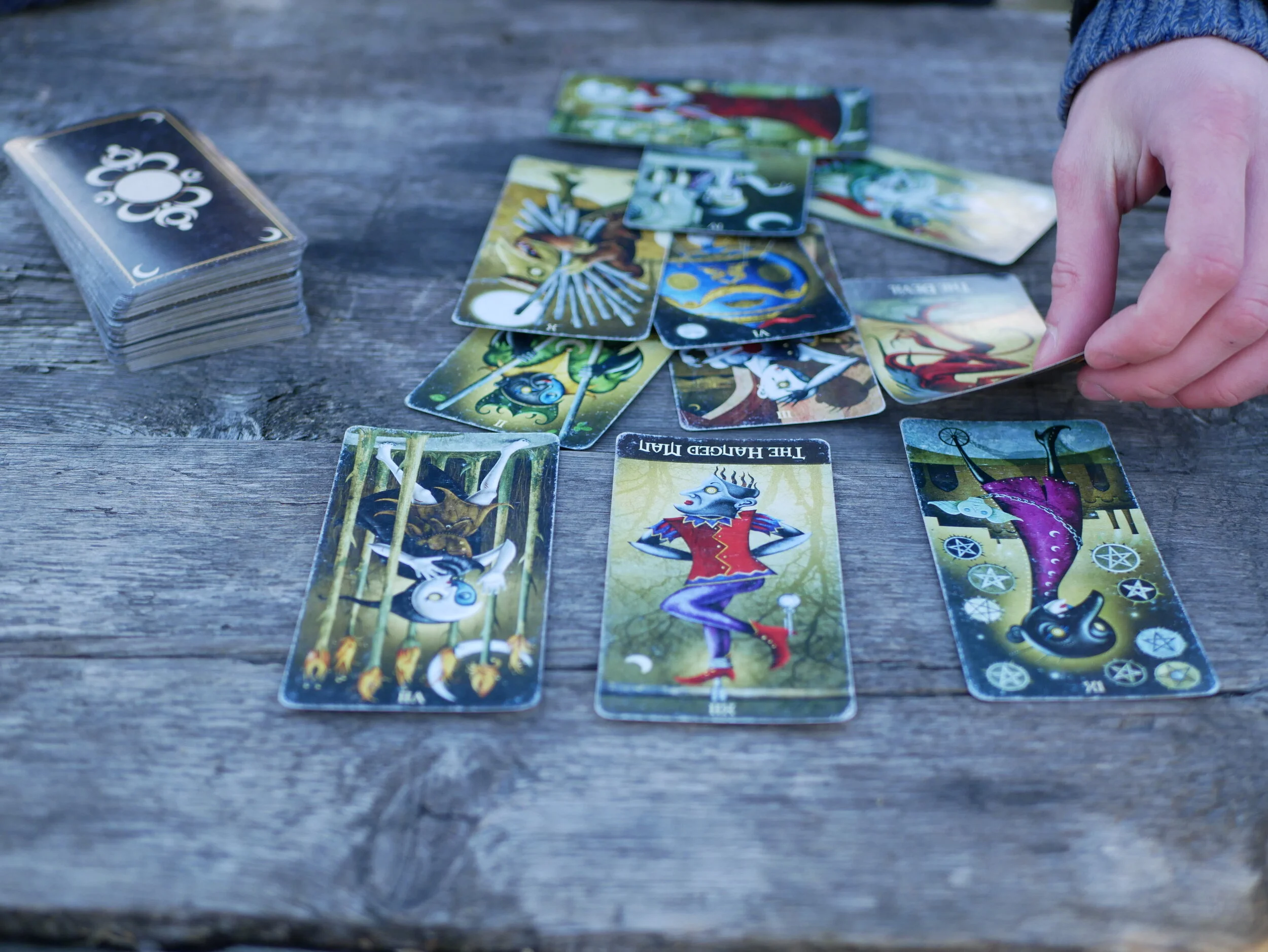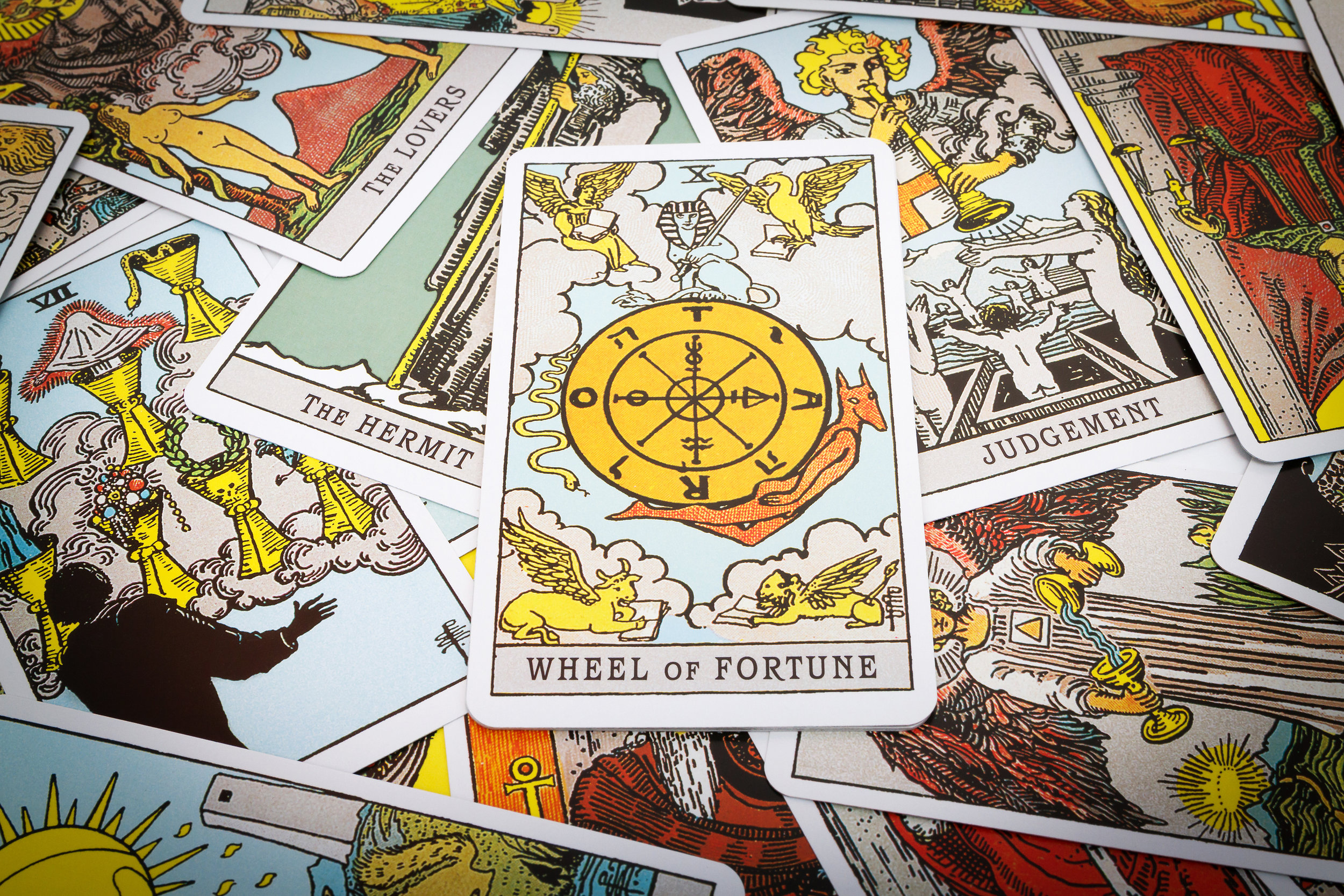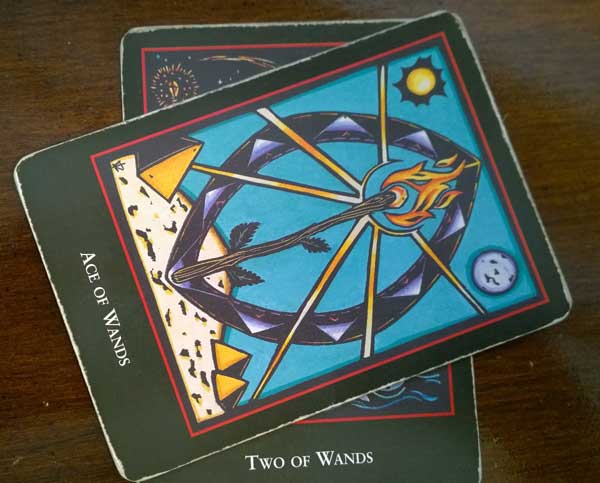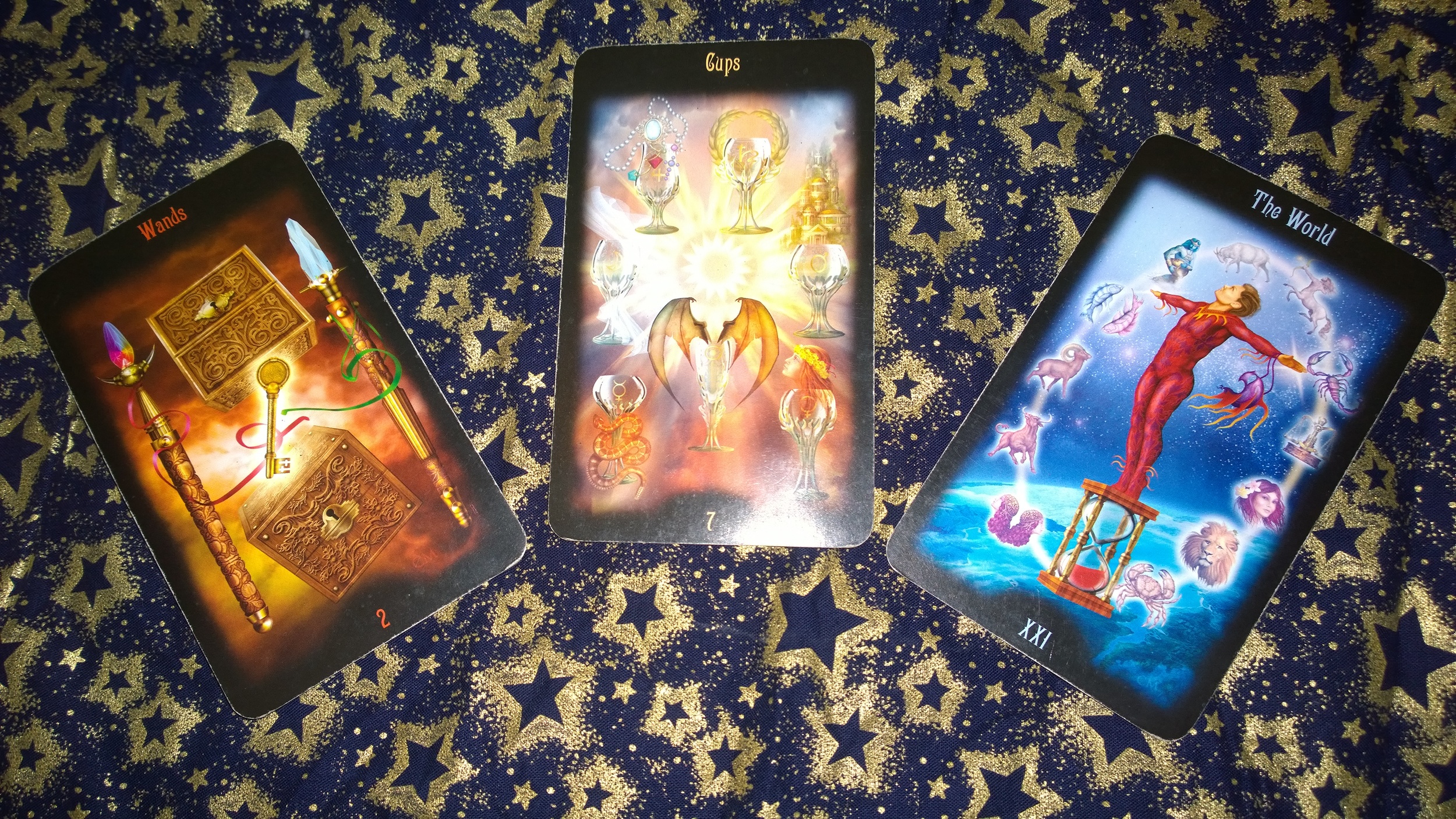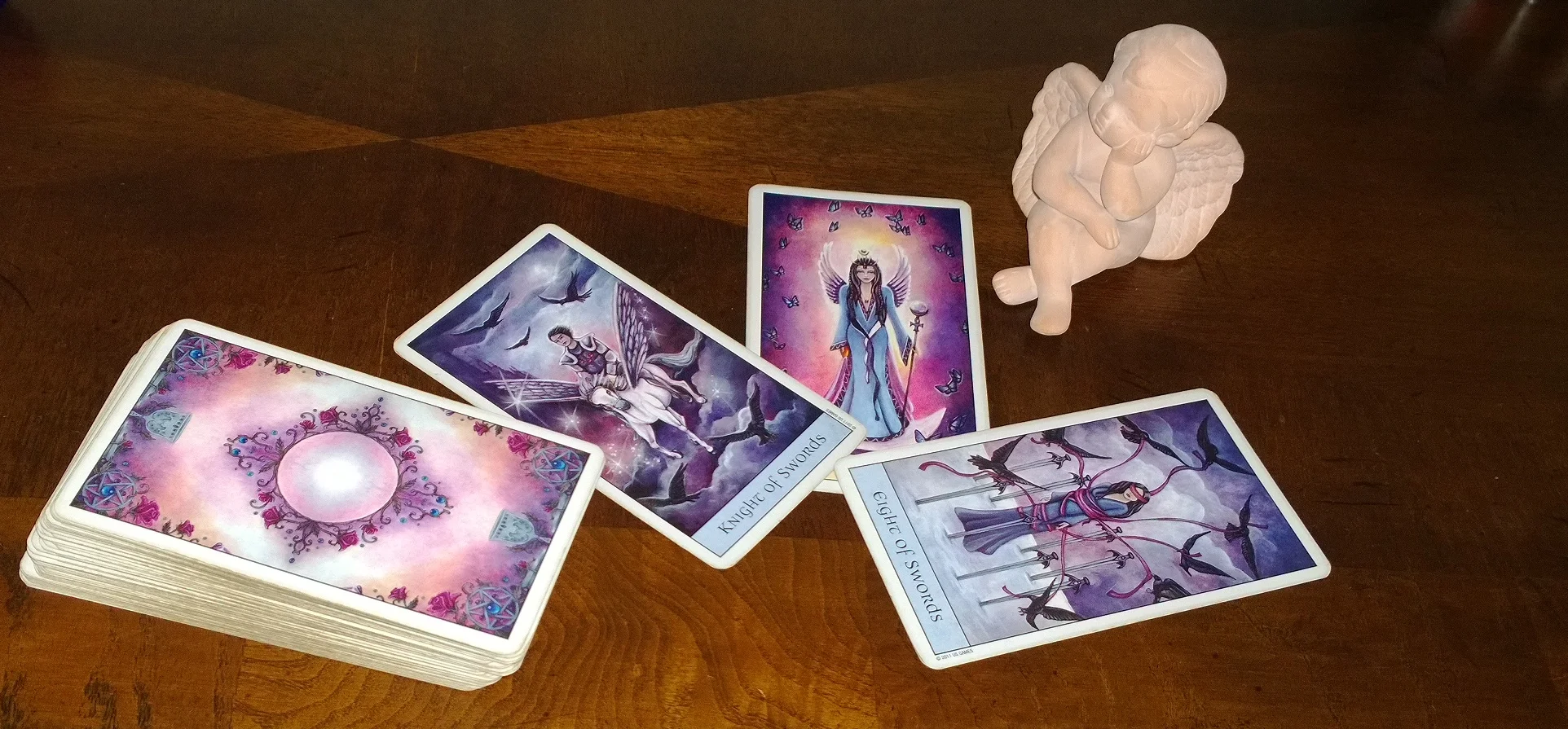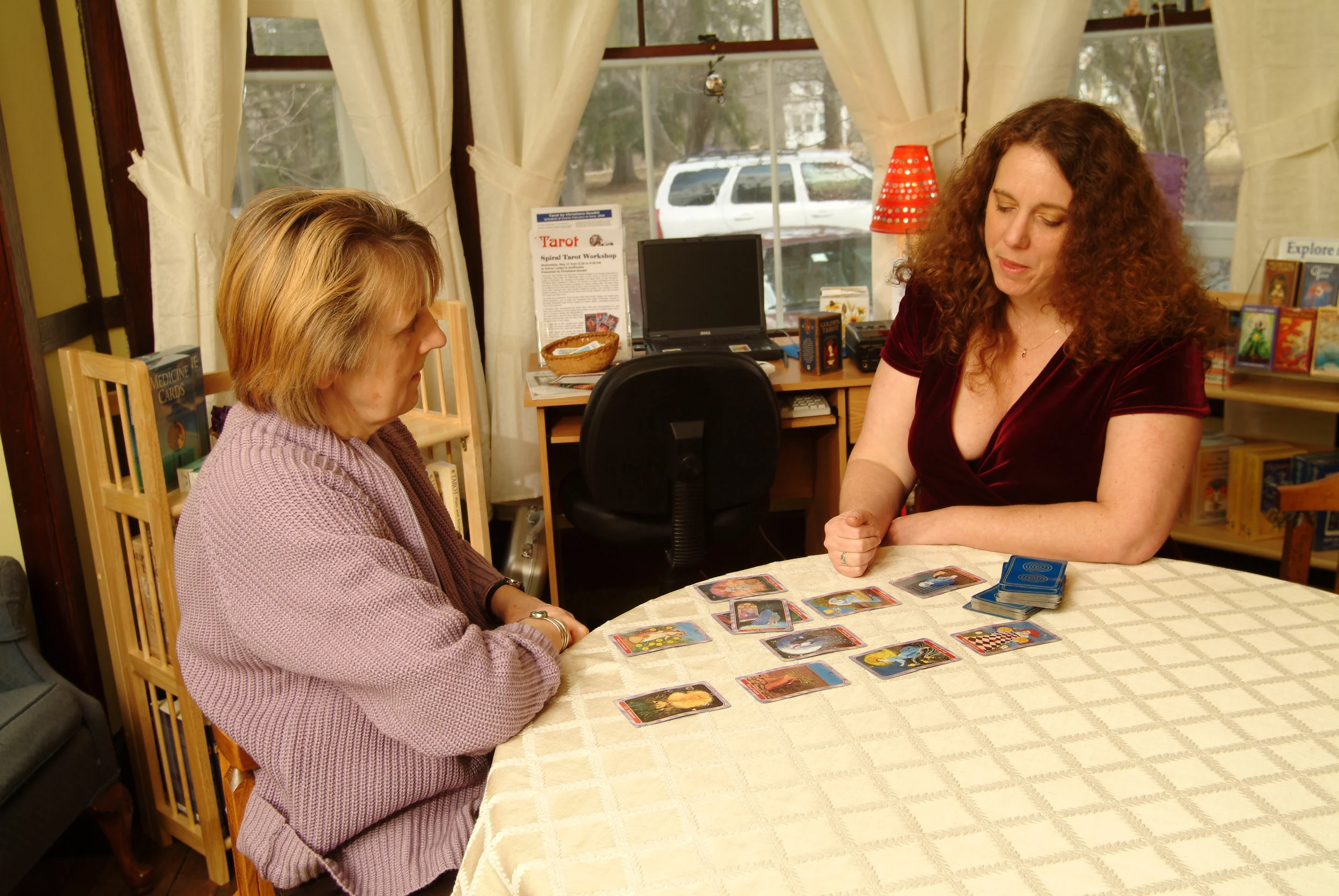
Welcome to my Community Blog for tarot enthusiasts.
Anyone with an interest in tarot, be they student, artist, collector, writer, teacher or reader, is welcome to
to include here.
Create Your Own Tarot Spreads
Every good tarot reader masters multiple tarot techniques. When we learn to create tarot spreads, we expand our tarot reading skills.
Create Your Own Tarot Spreads
A tarot spread is a diagram of card positions that allows you to do a helpful and understandable tarot reading. Typically, each position asks a question. The card that falls into that position must be read in the context of the position.
It is possible to do a good tarot reading without a positioned spread. It is also possible to include numerous spreads and techniques in a tarot reading session. Not every question calls for an entire spread. Yet, a good tarot reader needs to know when a tarot spread would be helpful, and how to most effectively work with a spread.
Each tarot spread has a theme. The spread may be comprehensive in that it addresses many or all departments of life. Or, a spread may be created to address a specific concern.
How the cards are laid out graphically can matter to the efficacy of a tarot spread. Sometimes the cards are meant to form a shape that relates to the theme of the spread. Whatever the graphic shape, we tend to notice how cards that are near each other interact with each other. We often create spreads that are like trees, where a single card addresses a larger issues and multiple cards branch from that to answer questions about that issue.
There are many traditional spreads, many books of tarot spreads, and many spreads created by professionals and shared on social media. With so many available spreads, why would you want to create your own?
There are many possible reasons to create your own spreads. First and foremost, since working with tarot spreads is such an important skill, the act of creating spreads helps us become better at reading spreads.
The act of making spreads is in itself creative, and therefore, fun. It’s also fun to share the spreads we create with others.
No matter how many spreads exist in the world, there is always room for more. There are an infinite number of questions we can answer with tarot.
As we work to create new spreads, we sometimes stumble onto new ways of working with the cards, and new techniques that improve our tarot practice.
Tarot spreads can have as few as two cards, or as many as seventy-eight.
When you create your own spread, it will likely fall into one of three categories.
You might create a comprehensive spread. This would be a larger spread, perhaps ranging between six and fifteen cards. You would want each position to reflect an aspect of life. The goal of this spread would be to get as complete a picture as possible of what is going on in a person’s life. Traditional comprehensive spreads include the Celtic Cross and the Astrology Wheel.
Another type of spread is a themed spread, or a situational spread. A themed spread might be created for a specific holiday, or a specific time of astrological transition, such as a full moon or a mercury retrograde. The graphic shape made by the cards might reflect this theme.
A situational spread could be created to use to answer a specific type of question, such as how to handle a relationship problem, or how to make a career transition.
These sorts of spreads can be shared with others and can be performed when need arises or when the time is appropriate.
It’s also possible to create a spread for a single use. These spreads are often the most powerful. I will occasionally use this method when a client presents with a unique and multi-faceted problem.
A single-use spread is likely to include many cards. You may also add positions as you are performing the spread, based on what the cards reveal.
A single-use spread allows you to break a complex issue into its components, and consider all aspects of the situation in order to find guidance, understanding and direction.
You can create a spread with a pen and a piece of paper, or you can create a spread using any sort of word processing or graphic software.
Sometimes, in a tarot reading, you might create a two- or three-card spread in the moment to answer a specific question. For example, if you are deciding whether or not to do something, you might pull one card to show what happens if you do it, and another card to show what happens if you don’t.
The more you allow yourself to explore tarot spreads and tarot reading techniques, the better you will become as a tarot reader.
Want to Ask Tarot if You Should Do Something? Try This Technique Instead!
Need to make a decision? Try this technique to get a quick, clear tarot reading!
There are a few really great tarot groups on social media where folks share readings they perform and ask other group members to share thoughts and interpretations to offer a clearer understanding of the reading.
Very often the readings consist only of three cards with no positional meanings and a poorly worded question. This sometimes leads to confusion and misunderstanding, rather than the clarity we hope to glean from a tarot reading.
Tarot is like any other tool, your success with it will be determined by your own skill and technique.
One sort of question that really does not lend itself to the three-card non-positioned spread is a question that begins with the word “should”.
Should I buy this car? Should I leave my job? Should I give Joe another chance?
Many smart tarot people shake their heads at the should questions because, by definition, a should question is a “yes-or-no” question. Many people feel that tarot is not well-suited to answer yes-or-no questions. The thing is, many of our questions for tarot do involve decisions. I think we can get good information to help with our decisions if we use the right phrasing and technique.
If you ask, “Should I buy this car?” and lay out three cards with no positional meaning, it will very likely be hard to understand what the cards are actually saying to you.
Try this instead.
You can do this technique as a tarot spread, or simply ask questions and pull cards – the result will be the same.
Ask “What will be the result if I buy this car?” and pull a card. Ask “What will be the result if I don’t buy this car?” and pull a card. Perhaps you would like to ask, “What will be the result if I look for a different car?” or, “What if I don’t buy a car at all?”
By breaking your question into multiple questions that anticipate all possible options, and by replacing the phrasing of “should I” with “what would be the result if I” you will drastically increase your chances for a clear, helpful, insightful tarot reading.
Answers to Your Questions about Tarot: Why wouldn’t you want to do a reading?
I'm adding to my library of videos on YouTube. This one answers a question about situations when we don't feel comfortable consulting the cards.
This question is from Katie, who wondered why she was reticent to perform a specific tarot spread about a new child in her life.
The spread was called “A Child is Born”, and had a very predictive tone to it.
I believe there are times when all things are possible, and predictions just aren’t helpful. The energy wrapped up in a brand new baby is like that – why try to limit the possibilities with predictions?
At these sorts of times, it might be best to ask different questions of the cards, such has, “How can I help this new person?” or “What do I need to know about this new person?”
Often, when we are reticent to go to the cards, it’s really the questions we are asking, or the spread we are using, that create the problem.
Enjoy the video!
Exploring The Crossing Card
Some thoughts, and Sway presentation, on interpreting the crossing card in the Celtic Cross tarot spread.
The Celtic Cross. In all its variations, is a very well-loved tarot spread. One of the reasons for its popularity, I think, is that it is comprehensive, addressing most areas of life.
My modified 11-card Celtic Cross is my favorite spread, and my go-to spread for virtually all professional readings I do. You can find this spread in both my books, Tarot Tour Guide and Fortune Stellar.
Recently, I did an in-depth exploration of my Celtic Cross for a class in Tarot Town. Tarot Town members can view it in archive.
Preparing for that class got me thinking that many of the positions in the Celtic Cross are interesting and insightful enough to do a presentation on a specific position.
For me, no card position is more interesting, nor more telling, than the crossing card.
First, its very name, with its archaic charm, is both descriptive and mysterious.
In certain magickal cultures, the term “cross” refers to a hex or a curse. This is certainly in line with the crossing position in the Celtic Cross, which represents a challenge, obstacle or problem.
While some positions of the Celtic Cross may vary in their interpretation from reader to reader, virtually all readers will agree that the crossing card is read as a problem, challenge, issue, block or obstacle.
The crossing card is actually dealt across the center card, and is always read upright, because its very position allows for a lot of wiggle-room as we ascertain the dignity of the card.
Many readers interpret the crossing card as a direct obstacle regarding the card it crosses. Other readers will see the crossing card as representing the biggest challenger of all, which will not necessarily be what concerns the client most, nor particularly connected to the card it physically crosses.
The card that is crossed by the crossing card is generally interpreted as the current atmosphere, where you are right now, the present, or the situation.
Although I tend to interpret the crossing card as the biggest over-arching problem faced by the client, I do see great value in looking at the crossing card and the specific card it crosses, and finding the story within those two cards.
Often in readings I find that these two cards do indeed tell a poignant story.
Within that story, the crossing card can take on a number of roles beyond illustrating the challenge.
Sometimes the crossing card can indicate not only the problem, but also the cause of the problem, or, perhaps, a solution to the problem.
Sometimes the crossing card simply states the problem, and begs another question and more cards to indicate a solution.
It is also possible to perform a simple-yet-insightful 2-card reading based on this aspect of the Celtic Cross.
Let the first card represent the atmosphere, and let the second card cross the first, indicating the biggest challenge. You could also let the first card indicate a goal, and the crossing card indicate what it will take to reach that goal.
As a healing art, a tarot reading must get to the heart of a problem, and offer solutions. The crossing card is often an efficient tool in helping us do that.
Look through the presentation below to see some examples of crossing cards that have appeared for me in readings, and what they represented.
As a tarot exercise, try playing with this two card spread, and find the stories you can see in just two cards.
For further study, and evidence that great minds think alike, check out The Tarot Lady, Theresa Reed’s take on what she brilliantly calls “The Mini Cross.”
Please be patient - we are working to fix the link to the Celtic Cross interactive display!
Situational Spreads
A Situational Spread is a spread that we use to handle a specific situation. Decision-making spreads are situational spreads. We can have situational spreads that we rely on and use when needed. The “Help and Hinder” spread is a popular example of a reusable situational spread.
We can also design custom spreads for one-time use to work with unique situations. We can design these spreads on our own, or with the help and input of our clients. To work with a client to design the spread and then perform and interpret the spread is a very proactive and empowering approach to tarot reading.
What Situations Demand a Custom Situational Spread?
You can design a custom spread for any reading. Simply ask the client what their questions are and who the major players are and design a spread. You might want to pull some cards to help give insight regarding positions and the greater spiritual purpose of the reading.
Specific situations could include interpersonal issues, complex decisions, spiritual questions and questions of personal growth.
You might decide to create a spread after doing an initial general spread and discovering a complex issue. Get as much information as you can from the initial spread, then pick up the cards, shuffle, and go through the process of creating the situational spread.
How do you Design a Situational Spread?
Use a pen and paper, or a computer. The graphic layout of the spread is important. Be creative in the way you layout the cards as well as in your questions. Think about the layout as a flow chart, a graph or a chart.
If you design the spread neatly you can fill in the names of the cards that appear and give it to your client to take home.
You may use tarot divination to help inspire the right questions.
You may choose to design your spread in Sacred Space.
You may create positions for each person involved, and for each possible decision. In a decision-making spread it is wise to include a position for options that have not yet emerged, as well as positions for known options.
If you want specific information about a specific person you can make a position such as “What Does Sally Want?” You can do this instead of or in addition to a general position for the individual.
You may use standard positions, such as Past, Present, Future, Final Outcome, Hopes, Significator, Challenge, etc.
Remember that creating a position uses the same skills and considerations as phrasing a question. Open-ended questions are better than yes/no questions. Questions that empower the client and teach the client to be proactive often yield the best results. A question such as “How can I discover the truth?” is sometimes better than “What is the truth?’
There is no specific number of cards to use, but remember that tarot spreads tend to become cumbersome after 15 cards or so.
You can create “dynamic” positions to describe the dynamic between people. For instance, if you have three kids and want to know the dynamics between them, have one position for each kid and see how the cards relate to each other in that context.
Your position questions can be as general or as specific as you see fit.
Performing the Spread
Perform and interpret the spread as you would any other spread. But, remember that the creative, introspective, spiritual process that went into designing this unique spread will infuse the reading with a great deal of power.
Interpreting “People Positions”
When you use a position to generally signify a person, remember the card that comes up could indicate that person’s role in the situation, that person’s current attitude, that person’s current worry or mood, as well as give information about that person’s personality.
Interpreting “Future Predictions”
In any spread, use future predictions to get a sense of possibilities, and to create proactive solutions.
The Value of Small Tarot Spreads
In professional tarot reading, I like to use larger tarot spreads in order to get a more complete picture. But I also like to use small tarot spreads, too. A small spread can be only one, two or three cards.
There are a few reasons smalls spreads are helpful. First, if you are a new reader, small spreads will give you practice, and opportunity to learn the cards in action, without overwhelming you. Second, if you have only a short time in which to perform a divination, a small spread can give you the information you need quickly. Third, you can use a small spread, or many small spreads, as part of a longer comprehensive reading.
Here are some ideas for working with small spreads. These might be especially helpful to new readers, or readers interested in developing some helpful new techniques.
Interpreting Cards in Small Spreads
If you are a new reader, or a looking to get a new perspective on card reading, ask yourself these questions about each card you interpret.
-
How does the card make me feel?
-
What do I see in the image?
-
What do I know about the card?
-
What are the traditional interpretations (check books, class materials, Google)?
One-Card Readings
While a single-card pull can’t always give all the information you might want, pulling a single card in answer to a question can be a great way to check in with the Universe. Single card readings can also lead to dialogues with the cards which can provide a great deal of information.
For one-card readings, ask a specific question that is open-ended.
“What do I need to know about my job?”
“How should I prepare for my trip?”
“How can I best support my friend?”
When Interpreting Spreads of more than one care, you have the opportunity to see how the cards combine and influence each other, Consider:
What do the cards have in common, and what does that tell you?
How do the cards contrast, and what does that tell you?
Two-Card Spreads
Here are some two-card spreads to try.
-
Help and Hinder: How would a particular situation or solution help me, and how would it hinder me?
-
Either/Or: What do I need to know about my options?
-
Partnership (Why are we in each other’s lives?)
Three-Card Spreads
Here are some three-card spreads to try.
-
Past/Present/Future
-
Morning/Afternoon/Evening
-
Body/Mind/Spirit
-
Relationship
When performing small spreads, be specific about your questions.
A simple Past/Present/Future reading will make more sense if you give it specific questions, such as:
- What has been my spiritual purpose in the past, in the present, and what will it be in the future?
- What lessons did I learn in the past, what lessons am I learning now, and what will I learn in the future?
- What was my greatest asset in the past, what is it now, and what will it be in the future?
- What was my biggest challenge in the past, what is it now, and what will it be in the future?
The Body/Mind/Spirit Reading works better like this:
- What must I do to better support my body, mind and spirit?
- What are my biggest concerns regarding my body, mind and spirit?
- What is the greatest strength of my body, mind and spirit?
Daily practice with small spreads will give your tarot skills a lot of versatility and flexibility. Adding small spreads to your reading style will allow you the opportunity to produce a great deal of helpful information each time you consult the cards.
Tarot Spreads vs. Random Cards
Some tarot readers prefer to use spreads with defined positional meanings. Others prefer to pull a few cards and read them without benefit of positions. Those who use this method often have a predetermined number of cards they pull and a standard way to lay them out. Some lay them in a circle or a line or a pyramid.
All these methods are perfectly acceptable and appropriate. Much about tarot is "dealer's choice." On a more spiritual level we can say that each reader needs to find the way that feels right.
Sometimes spreads with predetermined positional meanings can be very helpful. The card that comes up as a "Crossing Card," for instance, can be very helpful when you look at the card and say "OK, this describes your biggest problem."
On the other hand, sometimes the cards themselves make more sense in general than they do in the positions. For me three things are true when reading spreads.
First, as with any tarot reading, each card can mean more than one thing at the same time and can be interpreted in more than one way in the same reading.
Second, it is important to try to find an interpretation within each position that works, but if that's not possible in the time you have simply interpret the card in the context of the reading. Remember that not every card is equally weighty. If the interpretation doesn't come to you don't worry about it. Just move on.
Third, once you have interpreted the spread you can add more to the reading by simply looking at the cards without thinking about the positions. Look for card similarities and dissimilarities. Look for the ways the cards work together and the trends in distribution. Pull as much meaning from the cards as you can without worrying about the positions.
The bottom line is this. The card positions can give helpful information but the reading doesn't stop there. Look beyond the positions to get more of the story.
Pulling random cards can be very helpful, especially in a dialogue with the cards to answer specific questions. Allowing ourselves to pull as many cards as seems right is a way of opening our intuition to the wisdom of the Universe, which is what tarot reading is all about.
In a professional reading I tend to use both methods at once. I start with a specific spread which I interpret in as many ways as I can. While interpreting that spread I find areas where we need more information and need to go deeper. For me, the opening spread generates the questions of the reading.
Once that process is complete I pick up the cards and shuffle them and begin the dialogue process. I ask the specific questions and pull random numbers of cards to find the answers.
This is a technique that developed over time for me. In a reading I like to use a lot of cards. I like to pay attention to trends, and to pay attention when a specific card comes up more than once. Some readers prefer to use a more limited number of cards and dig deep into the possibilities each card presents.
It is important for good readers to understand the many techniques that are at our disposal. Our intuition will guide us to the techniques that will be most helpful in specific situations. Sometimes it makes sense to design a custom spread. Sometimes it makes sense to use more than one deck in a reading. Sometimes a spread with positional meanings is what's right. Sometimes a non-positional spread is better. Sometimes a dialogue does the trick.
Take the time to learn all the possibilities and then allow the Universe to guide you to use the ones that feel right for you.
Create a Custom Tarot Spread for a Specific Situation
Whether reading for yourself or another, there are many techniques for laying out the cards to find the answers you need.
One of my favorite techniques is to create a specific spread for the situation. You will need a pen and paper as well as your tarot cards for this.
The key to this technique is to be able to identify all the issues, players and questions that relate to the situation. Essentially, you need at least one position in the spread for each of these.
You might also want to include some traditional positions, such as:
- Significator: who the client is at this particular time.
- Challenge: the biggest challenge the client is facing.
- Helpful People or Influences: where the client could find help.
- General Advice: what the Universe advises the client to do.
- Past Influences: what the client brings from the past that has influenced the situation.
- Final Outcome: how this situation is likely to resolve.
The technique of creating a spread for a specific situation is particularly helpful for dream interpretation, solving issues of group dynamics, making career choices and deeper spiritual questions.
Once you decide that this technique is appropriate for a particular reading, make a list of each factor; that is, each position you want to include in the spread.
There should be a position for things such as:
- Each person in the situation
- What each person in a situation contributes, or feels, or thinks (consider more than one position for each person if you need to know more than one thing about each person)
- Each potential choice (what will happen if this is chosen)
- Each element in a dream sequence (when interpreting a dream, i.e. what does the book represent? what does the lamp represent, etc.)
- Spiritual factors (i.e. what is the spiritual lesson?)
Try to include every question you can think of, but also remember that spreads are best when they are fifteen cards or less.
Then, think about the graphic dynamic of the spread. Do you want the cards to make a particular shape? What is the best way to arrange the positions?
Draw the spread on your paper, assigning each position.
Finally, lay out the cards and perform the reading. You will find the insight you gain from your custom spread to be very enlightening!
Five Ways to use Clarifying Cards
Some readers use a bare minimum of cards. In fact some professional readers charge by the card! The techniques that I will discuss in this post are probably not well suited for those who prefer an economy of cards in a reading.
For those who tend to let the cards flow, clarifying cards can offer further information and greater detail in a reading. They can also spark other questions, and can help you understand cards that just aren't making sense.
Some readers use clarifying cards as a matter of course. Others use them only to narrow down a prediction, or to gain more information when they are confused by a particular card and how it might apply to the specific situation.
Because each card has so many possible meanings, clarifying cards can help the reader figure out which meaning(s) is/are most appropriate.
Here are some techniques that I use. None are techniques I learned from a book or teacher; they all developed organically over more than twenty years of reading tarot cards.
See how they work for you, and what other techniques you can develop!
1. Use a clarifying card to help you interpret a particularly confusing card. When you see a card that doesn't make sense, silently speak to the card and say "What are you trying to tell me?" or "What are you in reference to?" and pull another card from your deck. Place the clarifying card next to card that has confused you. See if the clarifying card answers your question. What happens if you blend the meanings of the clarifying card and the original card?
2. Use a clarifying card to digger deeper into the question. If the card already pulled answers the question but you want more detail, ask a more specific question and pull another card.
3. Use a second, smaller spread with a different deck, not disturbing your original spread, to gain definition, nuance and key points. Pay special attention if you see the same card twice!
4. Ask specific questions about the reading, such as "What is the best way to accomplish this?" or "What should my attitude be about this?" or "Where can I find assistance with this?" or "What is the spiritual purpose of this?" Draw one card, or a small group of cards, for each question.
5. Draw a final card to sum up the reading.
Clarifying cards are not for every reading, or every reader. But if these techniques feel right for you, give them a try and see what happens. You might be surprised at the detail and clarity you are able to derive!

